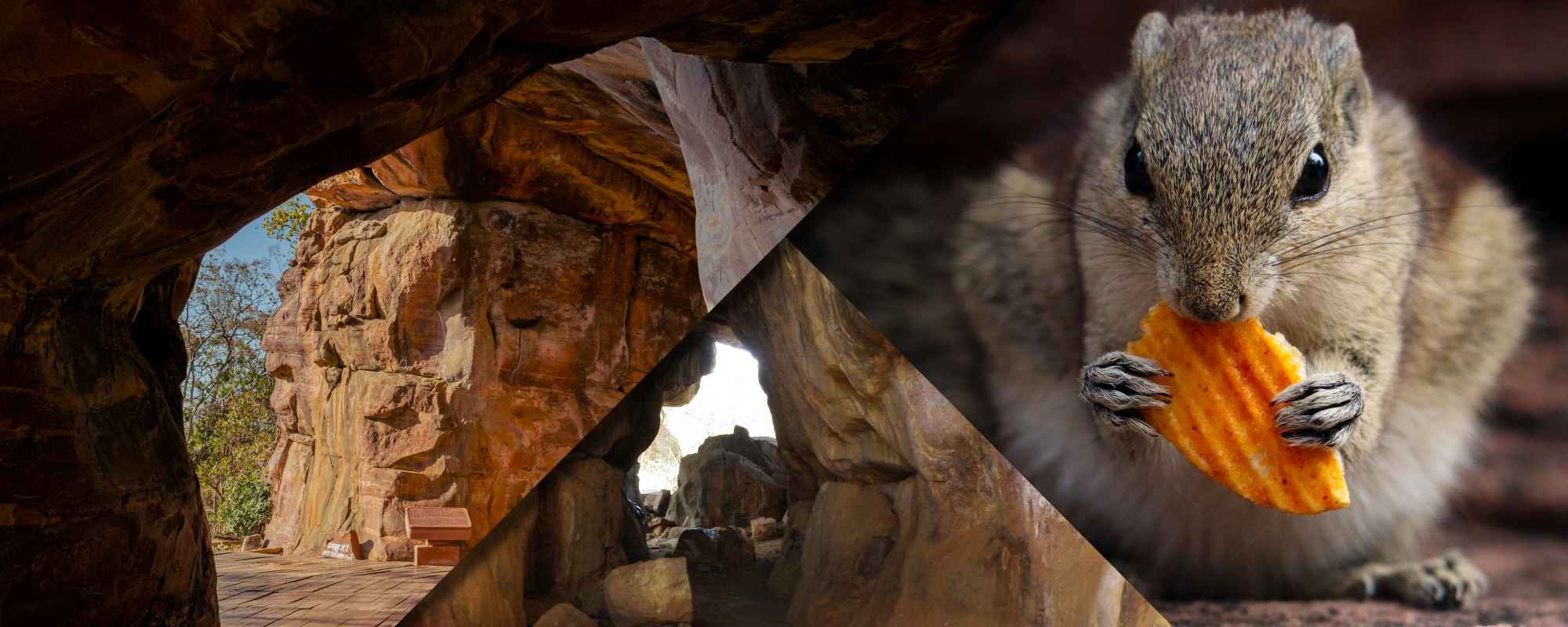
Nestled in the foothills of Vindhyachal Range in Madhya Pradesh, towards south of Bhopal, the renowned Bhimbetka rock shelters are an archaeological site which are the only evidence of the earliest human settlement on the Indian subcontinent hundreds of centuries ago. According to the evidence, these rock shelters in Bhimbetka are where the South Asian Stone age began and has elements spanning theprehistoric Paleolithic and Mesolithic as well as the historic periods.
These rock shelters exhibit evidence of Stone Age and Acheulian times. There are over 750 rock shelters and many of these have prehistoric cave paintings dating back to even 300 centuries and some of which were home to early humansmore than 1000 centuries ago. Bhimbetka, for this reason, has been declared a UNESCO World Heritage Site, and attracts history aficionados, archaeologists, and architecture enthusiasts from all around the world.
Bhimbetka’s rock shelters are some of the most ancient rock shelters where the earliest human life is said to have existed on the Indian subcontinent hundreds of centuries ago. In fact, evidence unearthed here by archaeologists suggest that this is the place where the South Asian Stone Age began. Many of the caves in the Bhimbetka rock shelters feature prehistoric cave paintings. While most of these are believed to be around 300 centuries old, some are said to have been inhabited by human residents more than around 1000 centuries ago!
The archaeological importance of the rock caves was not known to the world for a long time but much later in 1957, an Indian archaeologist named Vishnu Shridhar Wakankar discovered these rock shelters. After that, in excavation, nearly 750 rock shelters have been discovered as of now, out of which, 243 are part of the Bhimbetka group and 178 are part of the Lakha Juar group located nearby. According to the archaeological survey, these rock shelters were occupied until the 2nd century BCE.
Bhimbetka’s Rock Shelter include seven hills and comprise over 750 rock shelters which cover an area of over 10 km (6.2 mi). But out of these, visitors are allowed to explore only a specific 12 to 15 shelters or caves. These include an Auditorium Cave, which is the largest cave at the site, bordered by quartzite towers.
The caves where visitors are allowed also have various historic paintings of fighters, elephants with metal weapons, riders on horses, humans depicted as fighters or food gatherers, and battle scenes with people fighting with historic weapons like arrows, spears, bows and so on. It also includes a “Zoo Rock†that features paintings of various animals, such as elephants, deer, bison etc. Apart from these, the paintings also feature magical chariot flying in sky, tree gods, religious symbols, public dances, children and mother, dead animals being carried by men, burials, cooking, drinking, honey collection, childbirth, and much more.
The themes and motifs carved in these paintings such as hunting, dance, animals, geometric figure, etc., provide insight into the cultural evolution of humans. The paintings are colored using vegetable and fruit colors which have stood the test of time. The earliest paintings here are said to be about 30,000 years old, corresponding to the Indian Mesolithic times.Â
Bhimbetka Rock Shelters are situated in the Raisen district in the central Indian state of Madhya Pradesh and lie about 45 kilometers (28 miles) south-east of Madhya Pradesh’s capital city Bhopal .
The Bhimbetka caves (to where people are allowed) are open to visitors between 7.00 AM to 6.00 PM on all days of the week. An entry fee is applicable for every visitor, which is INR 25 for Indian citizens and INR 500 for foreign national visitors.
If travelling by personal vehicles, an additional entry fee is applicable for each for vehicle to enter, which is INR 100 for two-wheelers and INR 300 for four-wheelers.
Amongst many UNESCO World Heritage Sites in India, the Bhimbetka Rock Shelters are truly the essence of historic India and an embodiment of the lifestyle of primitive people. Consisting of the oldest-known rock art in India, Bhimbetka has 760 rock shelters from which 500 are decorated with paintings and the dense forest surrounding gives off total primitive vibes.
Vishnu Shridhar Wakankar, an archaeologist, had discovered the caves of Bhimbetka in 1957 which are known to be the earliest human settlement evidence in this part of the world.
The cave paintings of Bhimbetka date back to nearly 30,000 years in the rock shelters that were home to humans millennia ago.
Bhimbetka is a place known for its series of natural rock shelters dating millennia ago, in the foothills of the Vindhya Range, Madhya Pradesh.
The paintings in Bhimbetka are divided into several periods like Upper Paleolithic, Mesolithic, Chalcolithic, Early History, and Medieval History. They are present in 500 caves out of the 750.
Among others, red and white are the dominant colors used in rock shelter paintings.
Bhimbetka rock shelters can be visited from 7am to 6pm on all days.
Copyright 2012-2022 Indiamap Digital Pvt Ltd. All rights reserved. Privacy Policy | Terms of Use